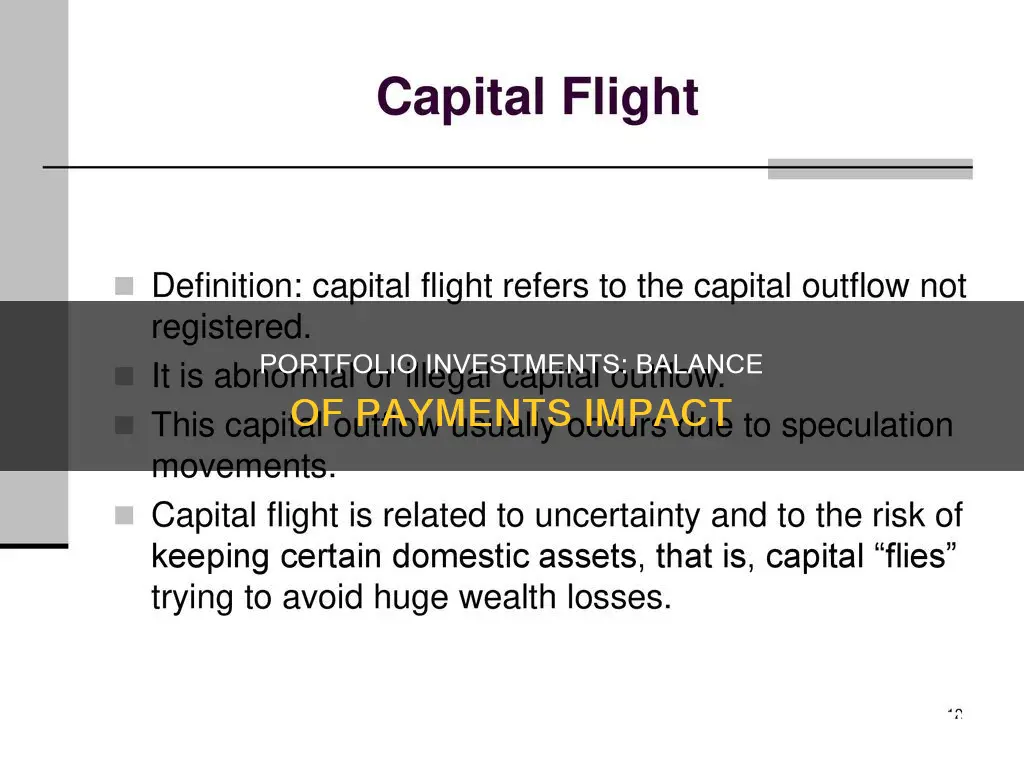
The balance of payments (BOP) is a record of international transactions between a country's residents and the rest of the world, including governments, businesses, and individuals. It is divided into three main categories: the current account, the capital account, and the financial account. The current account records the flow of goods and services, the capital account records international capital transfers, and the financial account documents investments in business, real estate, bonds, and stocks. Portfolio investments are a component of the financial account and cover transactions in equities, securities, and financial derivatives. These investments are considered traded or tradable, allowing investors to shift capital between instruments. A country's BOP can indicate its economic health, outlook, and strategies. A deficit in the current account, for instance, suggests a country is importing more than it exports, while a surplus indicates the opposite.
| Characteristics | Values |
|---|---|
| Definition of Balance of Payments (BOP) | The method countries use to monitor all international monetary transactions in a specific period. |
| BOP Calculation | Calculated every quarter and calendar year. |
| BOP Components | The current account, the capital account, and the financial account. |
| Current Account | Records the flow of goods and services in and out of a country (imports and exports). |
| Capital Account | Records international capital transfers. |
| Financial Account | Documents international monetary flows related to investment in business, real estate, bonds, and stocks. |
| BOP Ideal Balance | Theoretically, the BOP should be zero, with assets (credits) and liabilities (debits) balancing each other out. |
| BOP Imbalance | In practice, the BOP rarely balances, indicating a country's deficit or surplus. |
| Portfolio Investment | A component of the financial account, covering transactions in equities, securities, and financial derivatives. |
| Portfolio Investment Flexibility | Investors can shift capital between instruments, focusing on rates of return and the ability to move funds quickly. |
| Portfolio Investment Transactions | Classified as those involving an economy's financial assets and liabilities, including equities, bonds, money market instruments, and financial derivatives. |
What You'll Learn
- Portfolio investments are sensitive to market volatility and can be quickly withdrawn
- Portfolio investors seek higher returns and are more concerned about rates of return
- Portfolio investments are classified as either financial assets or liabilities
- Portfolio investments are traded or tradable, allowing investors to shift capital
- Portfolio investments can be in the form of equity, debt, or financial derivatives

Portfolio investments are sensitive to market volatility and can be quickly withdrawn
Portfolio investments are a component of the financial account, which is one of the three main categories of the balance of payments (BOP). The BOP is a record of all international transactions between a country's residents and the rest of the world, including government transactions. The financial account specifically documents international monetary flows related to investments in business, real estate, bonds, and stocks.
For example, if there is a downturn in equity markets, a portfolio with a higher allocation of stocks than intended could result in a larger drop in overall portfolio value. In this case, it would be necessary to rebalance the portfolio to restore the original desired weightings of portfolio assets. This is a process of restoring the weightings of portfolio assets to their original desired levels, which helps to maintain the right amount of risk and expected returns to achieve financial objectives.
Market volatility can also impact the balance of payments. Theoretically, the BOP should be zero, with assets (credits) and liabilities (debits) balancing each other out. However, in practice, this rarely happens, and the BOP can show if a country has a deficit or surplus. If there is a sudden reversal of capital flows, such as during a financial crisis, it can lead to a deficit in the BOP. This can occur when there is a significant withdrawal of portfolio investments, which are sensitive to market changes and can be quickly liquidated.
In summary, portfolio investments are a type of financial account transaction that is included in the BOP. These investments are sensitive to market volatility due to investors' focus on rates of return and their ability to quickly move funds. This sensitivity can lead to rapid withdrawals during market downturns, which can impact a country's BOP and result in the need for portfolio rebalancing to manage risk and maintain financial objectives.
Strategies for Evaluating Your Investment Portfolio
You may want to see also

Portfolio investors seek higher returns and are more concerned about rates of return
Portfolio investors are more concerned about rates of return than direct investors. This is because portfolio investments are independent of any influence investors may have on the underlying maturity of the instrument. Portfolio investors seek higher returns and the flexibility to shift invested capital from one instrument to another. This means that they can move funds quickly if circumstances dictate a change.
The portfolio investment component of the financial account covers transactions in equities, other securities, and financial derivatives. These transactions are classified as those involving an economy's financial assets and financial liabilities. Within these classifications, there are four types of instruments: equities, bonds and notes, money market instruments, and financial derivatives.
The essential characteristic of instruments classified as portfolio investments is that they are traded or tradable. This means that investors can shift invested capital from one instrument to another, regardless of the underlying maturity of the instrument. This flexibility is particularly important for portfolio investors as they seek higher returns and are more concerned about rates of return than direct investors.
The balance of payments (BOP) is the method used by countries to monitor all international monetary transactions within a specific period. The BOP is usually calculated every quarter and calendar year. All trades conducted by both the private and public sectors are accounted for in the BOP to determine how much money is entering and exiting a country. The BOP is an important indicator of an economy's health and can provide insight into a country's economic outlook and strategies.
The BOP is divided into three main categories: the current account, the capital account, and the financial account. The current account records the flow of goods and services in and out of a country, including tangible goods, service fees, tourism receipts, and money sent to other countries. The capital account measures the capital transfers between residents and foreign residents. The financial account reflects increases or decreases in a country's ownership of international assets.
The BOP is a useful tool for understanding the flow of resources between countries and can provide insights into the economic health and strategies of a country. Portfolio investors play an important role in the BOP as they seek higher returns and are more concerned about rates of return, allowing them to quickly move funds if circumstances change.
Creating a Diverse Investment Strategy: Portfolios to Consider
You may want to see also

Portfolio investments are classified as either financial assets or liabilities
Portfolio investments are a collection of financial investments, such as stocks, bonds, commodities, cash, and cash equivalents, including closed-end funds and exchange-traded funds (ETFs). They are classified as either financial assets or liabilities.
Financial assets are expected to earn a return or grow in value over time, or both. Financial assets can be anything from stocks, bonds, cash, real estate, art, and even gold. Financial assets are generally considered a portfolio's core building blocks.
Liabilities, on the other hand, are financial obligations or debts. In the context of portfolio investments, liabilities refer to the money owed by an individual or entity to others. While liabilities are not typically considered part of a portfolio's core holdings, they can include financial instruments such as loans, mortgages, or other forms of debt.
The balance of payments (BOP) is a record of all international transactions between a country and its trading partners over a specific period, usually quarterly or annually. The BOP consists of three main accounts: the current account, the capital account, and the financial account. The current account records the flow of goods and services, the capital account records international capital transfers, and the financial account reflects changes in international asset ownership.
Portfolio investments can impact the BOP. For example, if a country's residents purchase foreign stocks or bonds, these transactions would be recorded in the financial account of the BOP. If a country's residents receive income from their portfolio investments abroad, this would be recorded as a credit in the current account. Conversely, if they make payments on their portfolio investments, this would be recorded as a debit in the current account.
The BOP should theoretically balance, with credits (assets) and debits (liabilities) offsetting each other. However, in practice, this rarely happens, and the BOP can provide insights into a country's economic health, indicating whether there is a surplus or deficit.
Investment Portfolio Strategies: Corporations' Key Considerations
You may want to see also

Portfolio investments are traded or tradable, allowing investors to shift capital
Portfolio investments are a component of the financial account, which is one of the three main categories of the balance of payments (BOP). The BOP is a record of all international transactions of a country's residents, including both the private and public sectors. The BOP is calculated quarterly and annually and is used to determine a country's economic health and outlook.
Portfolio investments specifically cover transactions in equities, other securities, and financial derivatives. These include short- and long-term instruments and are characterised by their tradability, allowing investors to shift capital from one instrument to another. This flexibility is particularly attractive to investors who prioritise rates of return and the ability to move funds quickly.
In the context of the BOP, portfolio investments are recorded as debits in the financial account when capital is transferred out of a country for investment purposes. The return on these investments is then recorded as a credit in the current account. Conversely, when a foreign country earns a return on investments, it is recorded as a debit in the current account.
The tradability of portfolio investments provides investors with the ability to quickly shift their capital, making it an attractive option for those seeking higher returns or needing to move their funds rapidly.
Understanding Churning: When Your Broker Overtrades Your Portfolio
You may want to see also

Portfolio investments can be in the form of equity, debt, or financial derivatives
The balance of payments (BOP) is a record of all international transactions between a country and its trading partners over a specific period, usually calculated quarterly and annually. It is divided into three main categories: the current account, the capital account, and the financial account.
The financial account, which documents international monetary flows related to investments, includes portfolio investments. Portfolio investments can be in the form of equity, debt, or financial derivatives. Equity investments refer to stocks or shares, where investors buy ownership stakes in a company. Debt investments, on the other hand, involve bonds and mortgages, where investors loan money to a company or government.
Financial derivatives are contracts whose value is derived from the performance of an underlying asset, such as stocks, bonds, commodities, currencies, or interest rates. Derivatives can be used for hedging against risks, increasing exposure to price movements for speculation, or accessing hard-to-trade assets or markets. They include forwards, futures, options, swaps, and collateralized debt obligations.
The inclusion of portfolio investments in the financial account of the BOP highlights the importance of these international investments in a country's economy. Changes in portfolio investments, whether in equity, debt, or derivatives, can impact a country's BOP, reflecting the health and outlook of its economy.
GIT Investment Portfolio: A Beginner's Guide
You may want to see also
Frequently asked questions
The balance of payments (BOP) is the method countries use to monitor all international monetary transactions in a given period. The BOP is calculated every quarter and every calendar year.
There are three main categories of the BOP: the current account, the capital account, and the financial account.
The financial account documents international monetary flows related to investments in business, real estate, bonds, and stocks.
Portfolio investment is a component of the financial account that covers transactions in equities, other securities, and financial derivatives. Portfolio investors are more concerned with rates of return and the ability to move funds quickly than direct investors.







